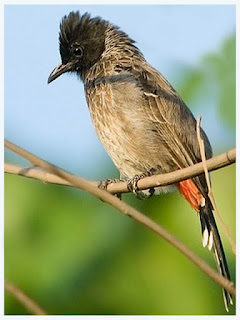
The breeding season of Red-vented Bulbul is from March to July.It builds its nest at the fork of a branch of tree or bush generally at a height of around 2-5 m (7-15 ft). Nests are occasionally built inside houses.The nest is cup shaped built with rootlets. Mostly three eggs are found which are pinkish in color blotched with brown.Both the parent incubates the egg for a period of 15-18 days. The chicks remain in nest and are fed for about 10 to 12 days by both the parents.They keep the nest clean by swallowing the fecal material.
This nest in above photograph is built in a Bougainvillea plant in my friend's house just in front of the main gate. I watched it regularly and taken few shots without disturbing the bird.This photograph is taken by my Nikon F801 camera with a 200 mm lens.This is a bright example of man and wildlife thriving side by side.Enjoy the bird watching and know the bird in your back yard.
This nest in above photograph is built in a Bougainvillea plant in my friend's house just in front of the main gate. I watched it regularly and taken few shots without disturbing the bird.This photograph is taken by my Nikon F801 camera with a 200 mm lens.This is a bright example of man and wildlife thriving side by side.Enjoy the bird watching and know the bird in your back yard.
![Reblog this post [with Zemanta]](http://img.zemanta.com/reblog_e.png?x-id=14419c4a-761b-46ed-b102-a4d860875dec)







